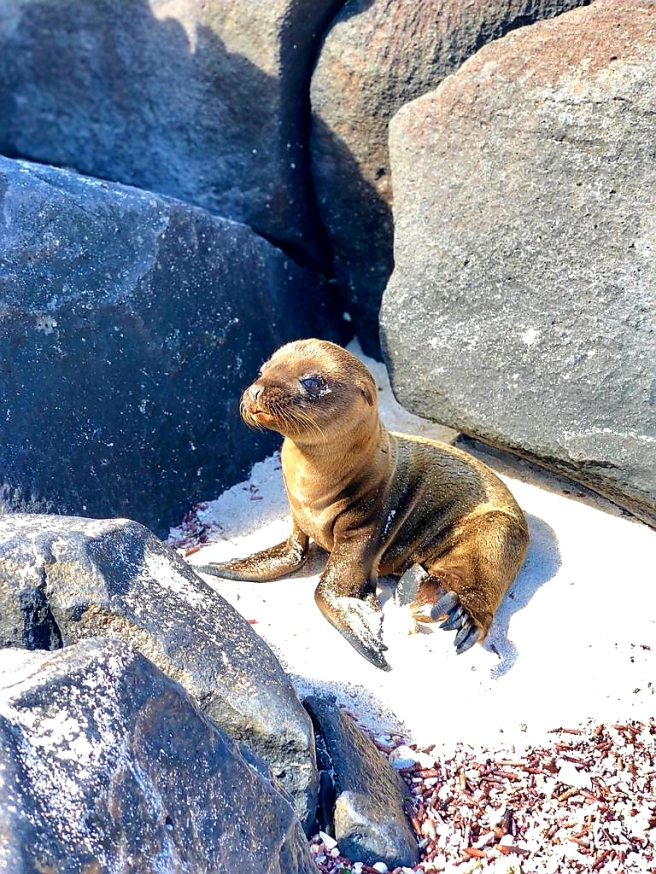It was a very early start – we left the hotel around 630am, picking up ‘breakfast in a bag’ as we went. Very kindly the owners of the hotel also got up early and made us some fresh coffee before we left.
We met our guide for the tour, Jose, at the shop where we had hired our wetsuits and fins from. We walked down to the main pier to meet the other members of the group. On the way there was a blue heron just happily perched on the railings.

And a bit further along we had a typical Galapagos scene with a pelican, a blue-footed booby and sally lightfoot crabs all together.

The pier is quite long and very picturesque.
As we were waiting for our boat we saw a sea turtle swim past.
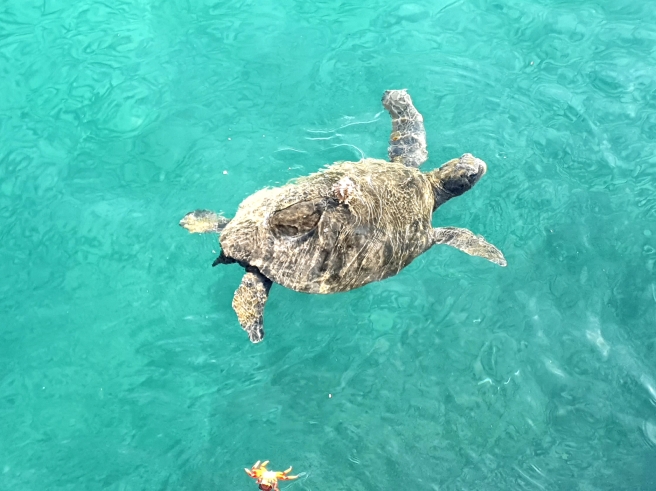
There were supposed to be a number of people joining us on the day trip but unfortunately many of the group who had planned to be in San Cristobal were flying in from Quito and because of the troubles in Ecuador at the time the flights had been cancelled so they were unable to join us. The Galapagos islands were not directly involved in the issues going on in Ecuador but the delays, changes and cancellations to flights were having some effects as people were unable to get to the islands. The trouble was caused because the government were planning to get rid of fuel subsidies and this was something that the general population were not too pleased about. Apparently though, this was just the surface of the problem and there were many underlying issues. Luckily there were no marches or protests happening on the islands but there were quite a few demonstrations in the cities on the mainland.
So, in total there were only four of us on the day trip; Faye and I and an Irish guy (I think his name was James) and another guide who was with the James, The other guide was called Lenka and she was originally from the Netherlands. She had been travelling and then met a guy whilst on the Galapagos islands and ended up coming back and marrying him.
The first stop was going to be Tortuga but in the way we passed Kicker Rock, otherwise known as Leon Dormido (sleeping lion). You can kind of see the shape of a lion with its head down and its tail pointing upwards. This is a sheer walled tuff cone that has been separated by erosion.
As we made our way to Tortuga bay we also passed the rock at Cerro Brujo, other wise known as witch hill. This hill is an eroded tuff cone and has been formed by lava that has low viscosity and few bubbles. This lava breaks whilst still solidifying and is pushed forward by lava that is still flowing from behind. People used to extract salt from the lake on the hill and use it to preserve food.

One part of the rock has been named ‘the cathedral’ and it is rather awe inspiring. The dark parts of the rock are from where the lava has flowed down the rock.
There was also a lava channel in the rock which is where the rock itself has been eroded by strong winds causing it to break.
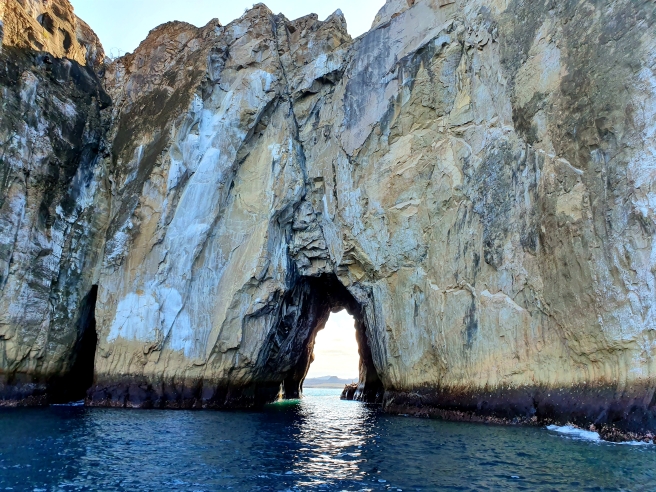
You could also get a great view of kicker rock through the channel.
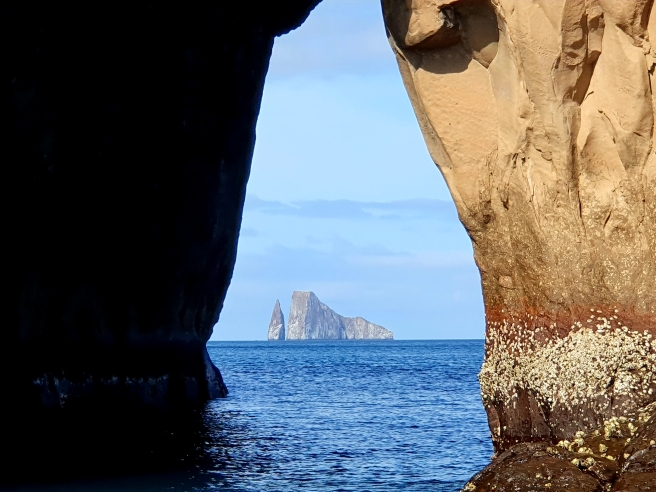
There were a number of pelicans perched on the rocks. Jose told us a story where Christians believed that the pelicans were giving parts of their bodies to their baby chicks and therefore worshipped them as martyrs. The reason they believed this is that when the adult pelicans feed their young they often spill the fish from their mouths and the people thought this was part of the pelican’s body.
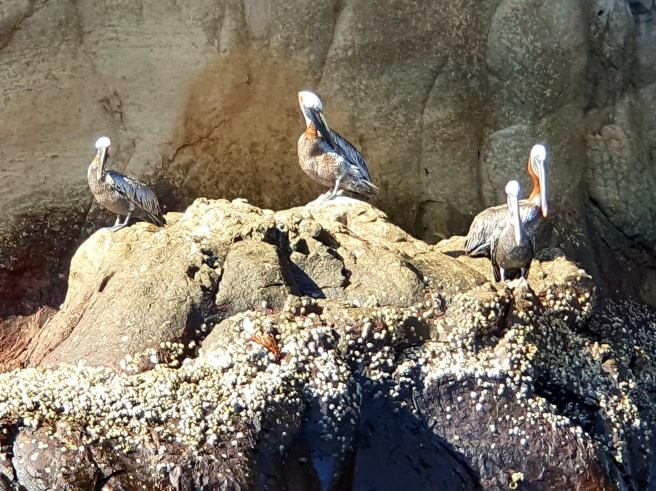
After a while we reached Tortuga bay. This has been formed by lava flows and uplifts and the temperatures here vary between 14-30 degrees Celsius.
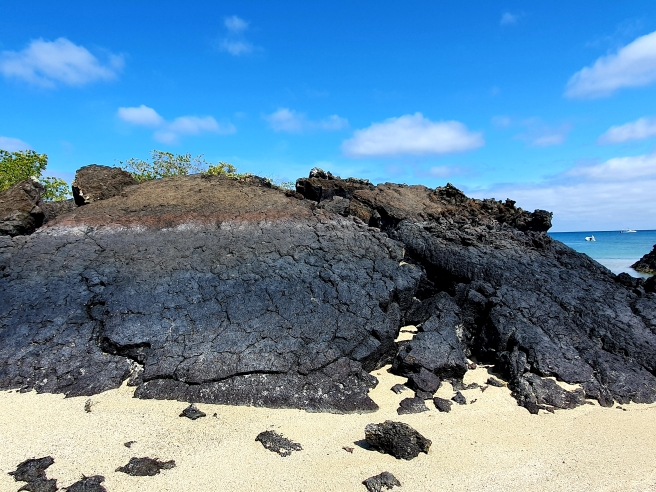
The white beachy area is formed form shells that erode and get smashed against the rocks.
Almost immediately we got onto the island we came across some mockingbirds. These particular mockingbirds are Chatham mockingbirds as San Cristobal used to be known as Chatham island. They colonised this island around 3-4 million years ago and are one of 4 species of mocking birds across the Galapagos islands.
There have been many eruptions over the years and the as the hot lava flows over the islands it kills the plants in its path. After the eruptions, lichen eventually establishes itself on the rocks and starts to break down the rock and form small areas of soil. This soil enables some plants to grow, which in turn, die and provide organic material for more plants to grow.
 The mangroves arrive via the ocean currents as the seeds are quite heavy and can be carried in the water. They help to form an ecosystem and provide food, nesting areas and refuge for animals. The population of the mangroves is increasing. Initially they were cut down s they cause areas to become swampy and smelly. but now, their importance is recognised as they can also act as a barrier against natural disaster.
The mangroves arrive via the ocean currents as the seeds are quite heavy and can be carried in the water. They help to form an ecosystem and provide food, nesting areas and refuge for animals. The population of the mangroves is increasing. Initially they were cut down s they cause areas to become swampy and smelly. but now, their importance is recognised as they can also act as a barrier against natural disaster.

We came across a natural lagoon which was more brackish as it was slightly salty. Some goats come to this area but they are an introduced species and they compete for food so their numbers are controlled.

We also came across a small collapse in the lava.
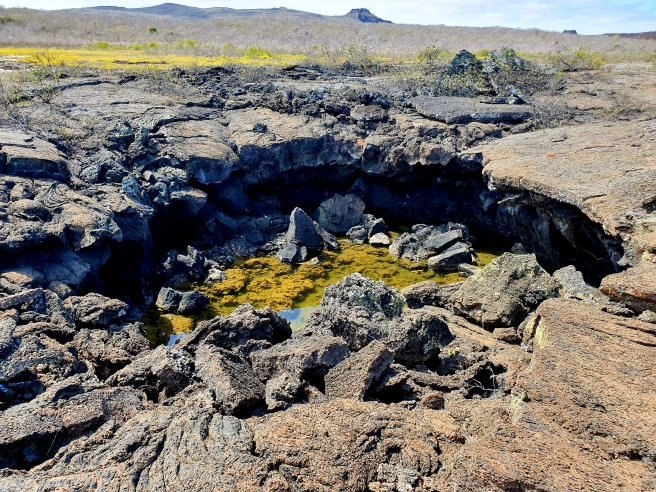
And then we came across something really weird – a couple of goat skulls on the rocks. Apparently some people kill the goats for the meats but they cut off the heads and the trotters as they are then lighter to carry off the island. You could still see the little goatee beards.
Amongst the rocks we found sally lightfoot crabs. These crabs got their name from a dancer. During the second world war Baltra (near Santa Cruz) was used as a military base. Different entertainment acts came and performed here, including Marilyn Monroe. One of the dancers who performed here was called Sally and the solders thought that she crabs moved like her and so named then after her. The crabs shed their shells as they grow and these can often be mistaken for dead crabs. It takes a few days for the new shell to harden and this is when they are at their most vulnerable.
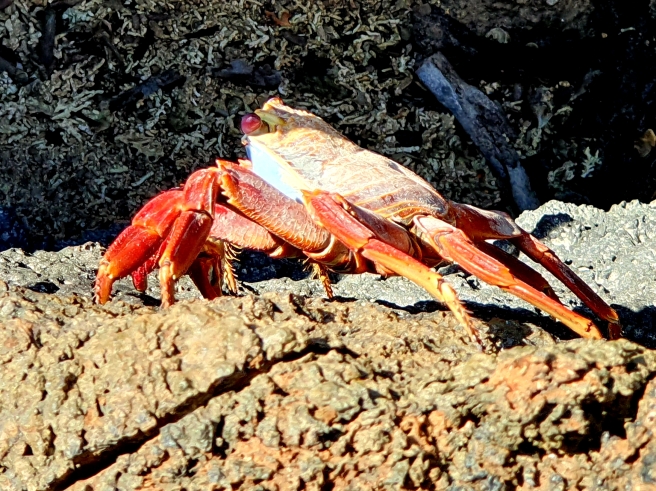
The majority of he lava is pahoehoe lava, which forms when the lava moves more slowly. We saw some spiral cones which form as the lava moves upwards and then rains down again. The lava takes many months to turn black, it is orange for around 3-4 weeks and then slowly starts to cool. The south of the island is greener than the north as the clouds move over the mountains and then deposit their moisture here.
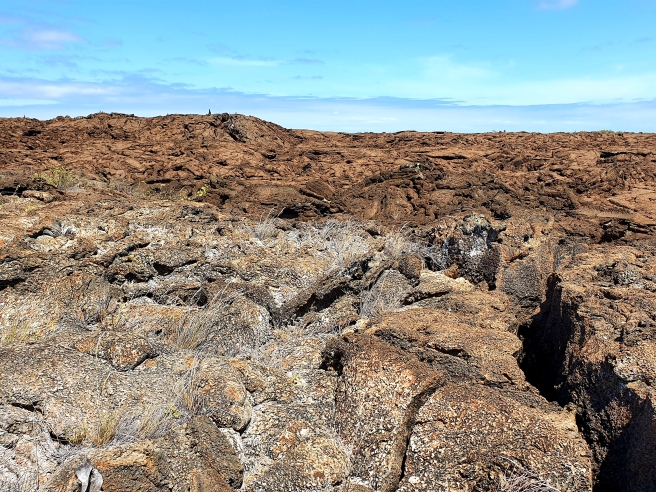
San Cristobal island is around 8 million years old but some of the lava is only around a 100 years old due to an eruption at this time. The island still does have dormant volcanoes.
From Tortuga bay we travelled to the beach at Cerro Brujo. This is a beautiful white sandy beach. Apparently the majority of the beach is from the poo of the parrot fish. These fish eat the coral and then poo it out to form the white sand and each fish can produce up to 1 tonne per year.
There was only our group on the beach so we all went our own ways to enjoy the scenery and the sealions and other wildlife.
The scenery was amazing and it was very relaxing just to wander around and sit down and take it all in.
The water also looked very inviting – but I knew how cold it would be so didn’t venture in!
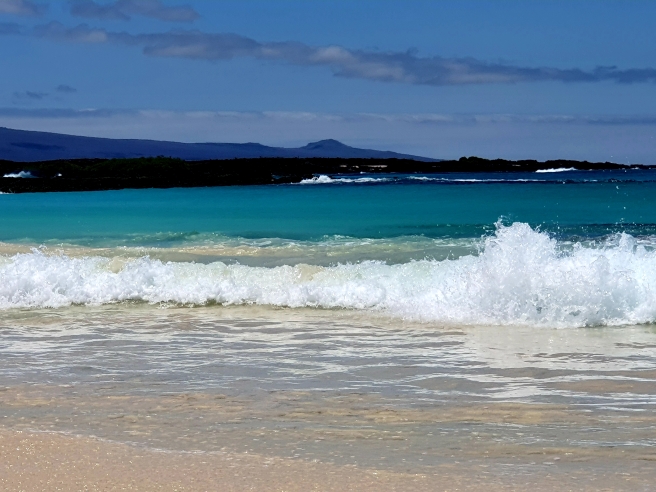
And of course there were colourful marine iguanas and sally lightfoot crabs around too
After our time on the beach we went back to the boat and had a delicious lunch of grilled fish with rice, crispy plantain and vegetables. It was delicious.
It was then time to snorkel. The boat travelled over to kicker rock and from here we jumped (or rather slid) from the boat into the water. Unfortunately James had never snorkelled before and he found it all a bit over whelming so he didn’t join us in the water.
The water was freezing, colder than any of the other days, as the water was really deep around the rock. But there was loads to see. I spotted a sea turtle almost immediately and as we swam along we saw around 20 of them, all swimming together – it was a fantastic sight! You can see how deep the water was as the sun reflects through it.
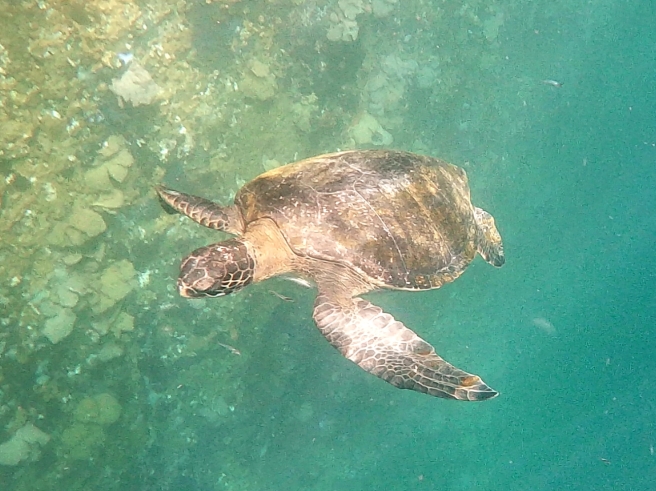
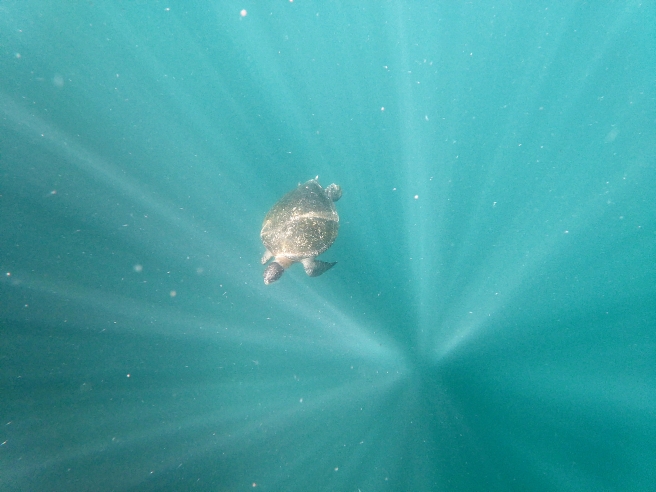
We swam around the rock and we saw more and more turtles as well as a huge range of reef fish. Faye and Lenka got out after about an hour but I stayed in for another 30 minutes or so. I was so glad I did too because later on I literally swam alongside a sealion for a couple of minutes – we were just swimming along looking at each other. I don’t have a photo but the guide took a short video which captures a bit of it. It was one of the highlights of the trip.
It took me a while to warm up once I was back on the boat but I really enjoyed the snorkelling. Once back on the boat I had a lovely hot cup of sweet tea and we headed back to Puerto Baquerizo Moreno.
At the port there were, as usual, sealions to greet us.
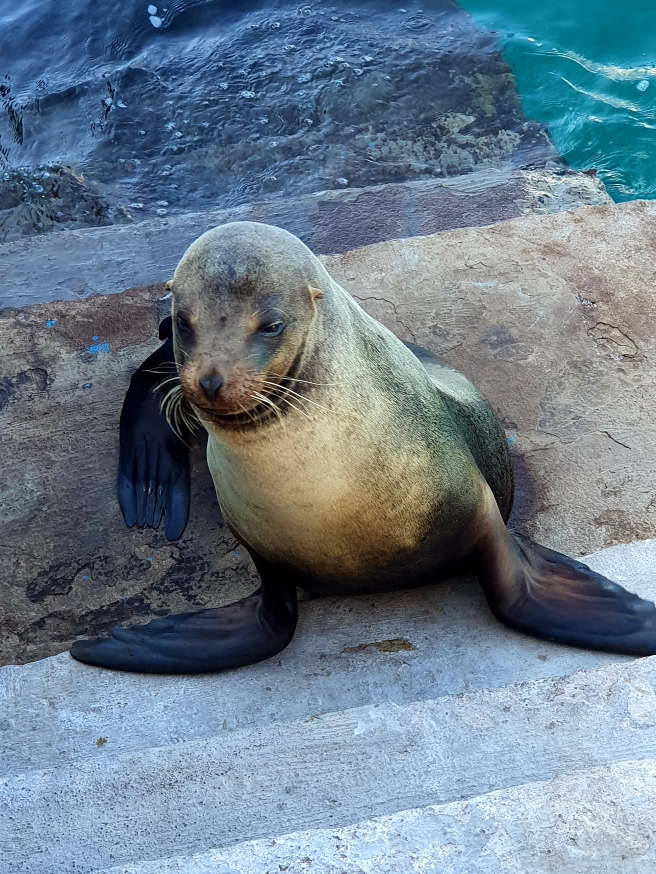
After dropping our wetsuits and fins back at the shop we decided to wander down the main street to see what else there was down that end.
There were a few statues to note and a shipwrecked boat which we later found out was a little souvenir shop, but with nothing particularly worth buying in it.
There was also a helpful map of the island.
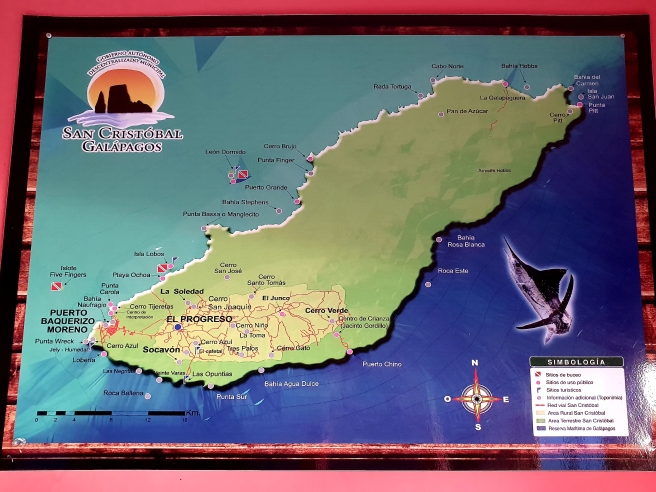
We then headed back to our hotel to watch the sunset from our balcony with a glass or two of wine.

And after the wine we walked back into town for dinner. We both had fish and chips in Midori – my fish was in an orange bbq sauce which was actually really nice.
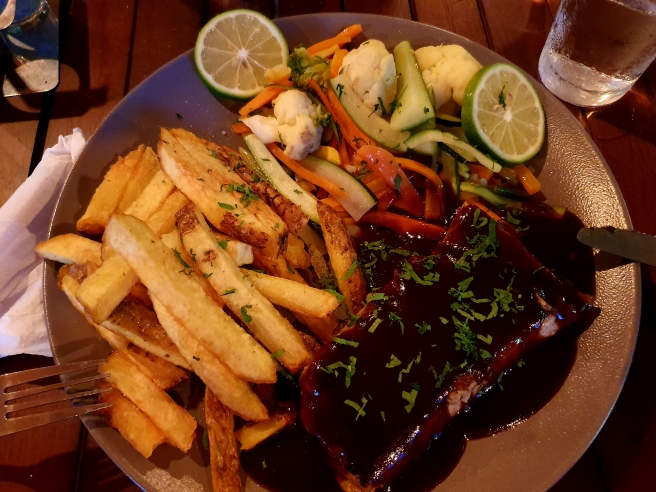
And the views on the way home were pretty good too.
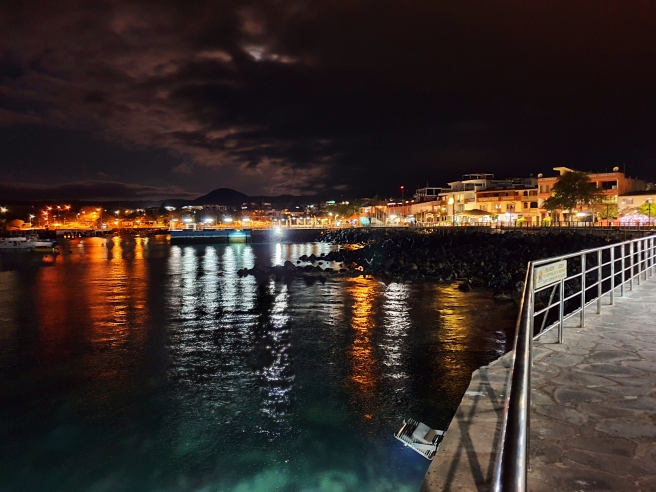
This is my favourite photo of today – Faye took it whilst on Cerro Brujo beach. Its just so cute.
